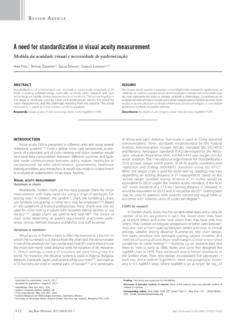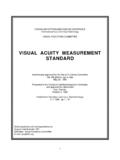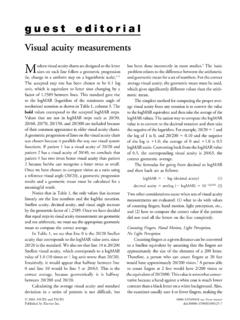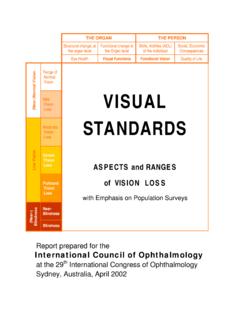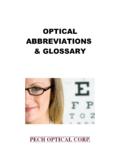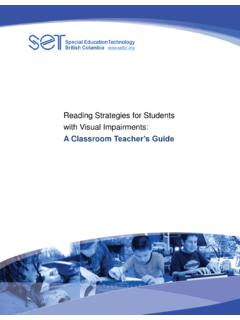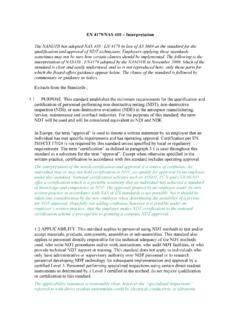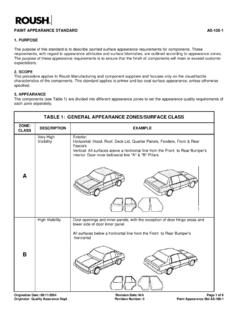Transcription of GOOD-LITE CATALOG - OneMed
1 Celebrating More Than 80 Years of Quality Since 1930 Color Deficiency Screening and TestingEnergy Efficient, LED-Illuminated CabinetsComputerized Screening and TestingTrial Frames and LensesLEDnowusingGOOD-LITE CATALOGV isit to see current pricing on all our productsGood-Lite reserves the right to increase or decrease prices due to unforeseen changes in manufacturers pricing. Prices are subject to change without advanced notification. The price we quote when an order is placed will not change. Celebrating More Than 80 Years of good -LiteLea Hyv rinen, MDLea Hyv rinen, MD, PhD, Professor , Rehabilitation Sciences, University of Dortmund, Germany; Senior Lecturer, Developmental Neuropsychology, University of Helsinki, Finland, started to develop her LEA Vision Test System in 1976 in Helsinki and has worked on it with Chris Greening in 17 years.
2 The Test System now contains tests for numerous clinical test situations and vision screening of children and adults with different communication needs. The original tests on the printed near vision card were: a standard test, a test with wide spacing and a tightly crowded test. There were two tests for distance, a hand-made grating acuity test and for low contrast, photographic tests at the same contrast levels as today. In early 1990s came the LEA Puzzle, first black & white, later colorful; Panel 16 color vision test; LEA GRATINGS; Cone Adaptation Test; Rectangle Game; Mailbox Game; Heidi Expressions Game and the LEA Numbers.
3 The additions of the recent years are LEA Grating Acuity Test, LEA Flicker Wand, the 40M and 60M cards for presentation as a line test or singly and the LEA Low Contrast Grating Acuity Hyv rinen s contributions to vision include training courses and lectures on functional vision testing for children with disabilities. The next pages depict the Core Tests and their numerous variants that are still available for numerous screening projects and Kay Nottingham Chaplin, EdDDirector, Vision and Eye Health InitiativesP. Kay Nottingham Chaplin, EdD, helped Geoffrey E.
4 Bradford, MD, pediatric ophthalmologist at West Virginia University (WVU) Eye Institute and member of the American Academy of Pediatrics Section on Ophthalmology Executive Committee, to create the Vision Initiative for Children, a program that trained and equipped individuals to screen the vision of preschoolers. Between Valentine s Day 2001 and Halloween 2008, Dr. Chaplin directed the program, conducted 178 workshops, and trained more than 1,600 individuals, including school nurses, Head Start personnel, and pediatric primary care providers, to screen the vision of preschoolers.
5 While working at the WVU Eye Institute, she also consulted about preschool vision screening for The GOOD-LITE Company. When the Vision Initiative for Children was unable to secure additional grant funds, GOOD-LITE employed Dr. Chaplin as Director of Vision and Eye Health Initiatives at GOOD-LITE . Partnering with GOOD-LITE gives Dr. Chaplin the opportunity to support and assist school nurses, Head Start personnel, pediatric primary care providers, and others, throughout the country. Her doctorate, from WVU, is in Special Education with an emphasis on early intervention special education and adult learning.
6 In her spare time, Dr. Chaplin researches eye chart history and eye chart 's Vision ExpertsThe GOOD-LITE Company is celebrating more than 80 years as the industry leader in illuminated cabinets; evidence-based eye charts, such as the LEA Symbols, and many more vision screening and testing products available in this CATALOG and combined efforts of Robert good , MD, Professor of Ear, Nose, & Throat at the Chicago College of Medicine and Surgery, and his son, Palmer good , MD, ophthalmologist, created the GOOD-LITE Company in 1930 with the development of the first GOOD-LITE medical.
7 Palmer added vision testing equipment to the product line and led the GOOD-LITE Company to its honored position among today s vision screening and testing s numerous achievements over the last 80 years are noteworthy. Palmer good worked closely with Louise Sloan, PhD, of the Wilmer Eye Institute at Johns Hopkins to develop the Sloan Letters for distance and near testing. GOOD-LITE is proud to have produced the first commercial chart using Sloan Letters, copyrighted in 1961 by Palmer good . Sloan letters continue to be the optotype of choice for many medical professionals, and were the precursor to ETDRS charts in worldwide use in clinical the 1970s, Palmer worked with Otto Lippmann, MD, to develop HOTV optotypes using Sloan letters.
8 Lippmann s HOTV optotypes a modified version of a Stycar matching letters test based on Snellen letters are useful for screening and testing vision of children as young as 2. The American Academy of Pediatrics, et al., includes HOTV optotypes on its list of recommended tests for preschool vision 2002, GOOD-LITE proudly received exclusive, worldwide manufacturing rights to the complete LEA Test System developed by Lea Hyv rinen, MD, PhD, pediatric ophthalmologist, of Finland. Dr. Hyv rinen started the first vision rehabilitation service in Finland in 1976, designed the LEA Symbols in 1976, and first described her 4 symbols apple, house, square, and circle in a peer-reviewed journal in 1980.
9 This System includes the LEA Symbols, the only pediatric optotypes that blur equally at threshold to prevent guessing, and the LEA Numbers. The core tests in this unique system assess near and distance visual acuity, contrast sensitivity, visual field deficits, cognitive vision, adaptation, and color deficiency. They are useful for screening and testing children of all ages, as well as for conducting functional vision assessments in children and adults with developmental delays/disabilities. The American Academy of Pediatrics, et al., includes LEA Symbols on its list of recommended tests for preschool vision 2003, GOOD-LITE became the point of contact for national and international distribution of the validated Color Vision Testing Made Easy by Terrance Waggoner, OD.
10 Dr. Waggoner s color test, useful for children as young as 3, is also an effective screening tool for color deficiencies in children and adults with developmental delays/disabilities. The test has been used successfully at multiple Special Olympics worldwide. GOOD-LITE values its key role in helping vision screeners and eye care professionals detect and treat vision disorders. We take pride in meeting the diverse needs of all those who assess vision, including the many clinical trials investigators who look to GOOD-LITE for state-of-the-art, evidence-based, standardized equipment.
